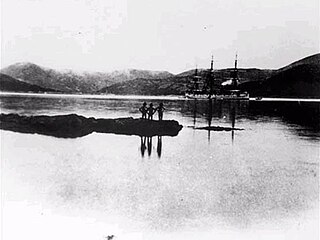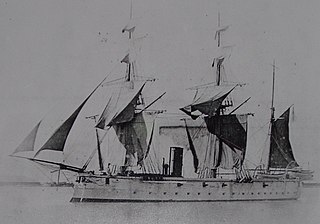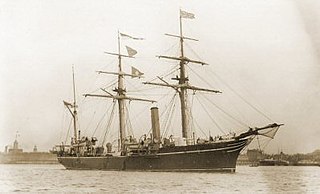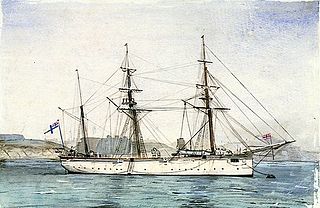
Steam frigates and the smaller steam corvettes, steam sloops, steam gunboats and steam schooners, were steam-powered warships that were not meant to stand in the line of battle. There were some exceptions like for example the French Napoléon class steam ship of the line was meant to stand in the line of battle, making it the world's first steam battleship. The first such ships were paddle steamers. Later on the invention of screw propulsion enabled construction of steam-powered versions of the traditional ships of the line, frigates, corvettes, sloops and gunboats.

HMS Kingfisher was a Doterel-class screw sloop of the Royal Navy. She was built at Sheerness Dockyard and launched on 16 December 1879. She conducted anti-slavery work in the East Indies in the late 1880s before being re-roled as a training cruiser, being renamed HMS Lark on 10 November 1892, and then HMS Cruizer on 18 May 1893. She was sold in 1919.

HMS Pegasus was a Doterel-class screw composite 6-gun sloop launched on 13 June 1878. She was sold for scrap in 1892.

HMS Algerine was a Phoenix-class steel screw sloop of the Royal Navy. She was launched at Devonport in 1895, saw action in China during the Boxer Rebellion, and later served on the Pacific Station. She was stripped of her crew at Esquimalt in 1914, and transferred to the Royal Canadian Navy in 1917, being commissioned as HMCS Algerine. She was sold as a salvage vessel in 1919 and wrecked in 1923.

The Amazon class was a class of six screw sloops of wooden construction built for the Royal Navy between 1865 and 1866.

HMS Reindeer was a Royal Navy Mariner-class composite screw gunvessel of 8 guns.

The Fantome class was a six-ship class of 4-gun screw composite sloops built for the Royal Navy during 1873 and 1874.

The Nymphe class was a class of four screw composite sloops built for the Royal Navy between 1885 and 1888. As built they were armed with four 4-inch guns and four 3-pounder guns.

The Alert class was a two-ship class of 6-gun screw steel sloops built for the Royal Navy in 1894.

The Phoenix class was a two-ship class of 6-gun screw steel sloops built for the Royal Navy in 1895. Both ships participated in the suppression of the Boxer Rebellion, but Phoenix was destroyed in a typhoon while alongside in Hong Kong in 1906. Algerine became a depot ship at Esquimalt, was sold in 1919, and was finally wrecked in 1923.

The Condor class was a six-ship class of 10-gun screw steel sloops built for the Royal Navy between 1898 and 1900. Condor foundered in a gale, prompting the Royal Navy to abandon sailing rigs for its ships; all the others in the class survived into the 1920s. The last of the class, Mutine, survived until 1932 as a Royal Naval Volunteer Reserve drill ship.

The Cadmus class was a six-ship class of 10-gun screw steel sloops built at Sheerness Dockyard for the Royal Navy between 1900 and 1903. This was the last class of the Victorian Navy's multitude of sloops, gunvessels and gunboats to be constructed, and they followed the traditional pattern for 'colonial' small warships, with a full rig of sails. After them, the "Fisher Reforms" of the Navy ended the construction and deployment of this type of vessel. All of the class survived until the 1920s, remaining on colonial stations during World War I.

HMS Mariner was the name-ship of the Royal Navy Mariner-class composite screw gunvessel of 8 guns.

HMS Icarus was a Mariner-class composite screw gunvessel of 8 guns, and the third Royal Navy vessel to carry the name. She was launched in 1885 at Devonport and sold in 1904.

HMS Hyacinth was an 8-gun Satellite-class composite sloop built for the Royal Navy, launched in 1881 and sold in 1902. She and the rest of her class were re-classified as corvettes in 1884.

HMS Basilisk was a first-class paddle sloop of the Royal Navy, built at the Woolwich Dockyard and launched on 22 August 1848.

HMS Nymphe was an Amazon-class sloop, of the Royal Navy, built at the Deptford Dockyard and launched on 24 November 1866. She served in the East Indies and Australia, and was sold in 1884.
The Greyhound class was a development of the Cruizer-class sloop, and comprised two 17-gun wooden screw sloops. They were both launched in 1859 and saw service with the Royal Navy until 1870. The class was reclassified as corvettes in 1862.

HMS Mutine was a Condor-class sloop of the Royal Navy. Mutine was launched on 1 March 1900. While being delivered from Birkenhead to Portsmouth an accident in Mutine's boiler rooms caused some loss of life and gave her a name as an unlucky ship before her career even began. She served on the China Station, then the Australia Station between December 1903 and February 1905 and later became a survey ship, surviving until 1932 as a Royal Naval Volunteer Reserve drill ship, the last of her class to be sold.
HMS Nymphe was a Nymphe-class composite screw sloop and the fifth ship of the Royal Navy to bear the name. She was renamed HMS Wildfire in 1906, HMS Gannet in 1916, and finally HMS Pembroke in 1917, before she was sold in 1920.

















